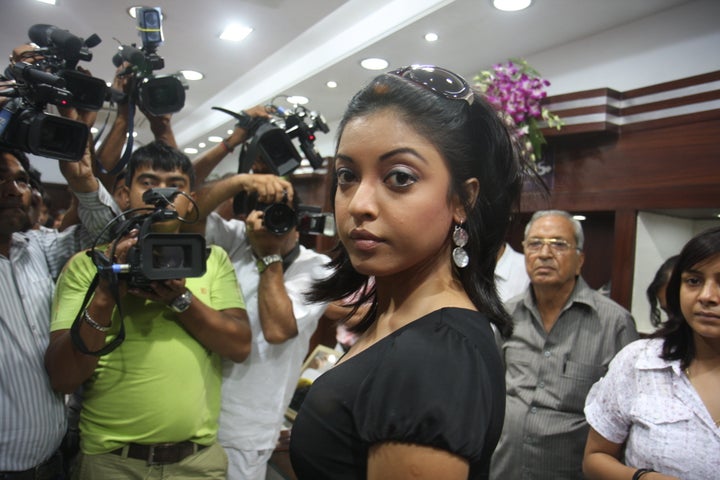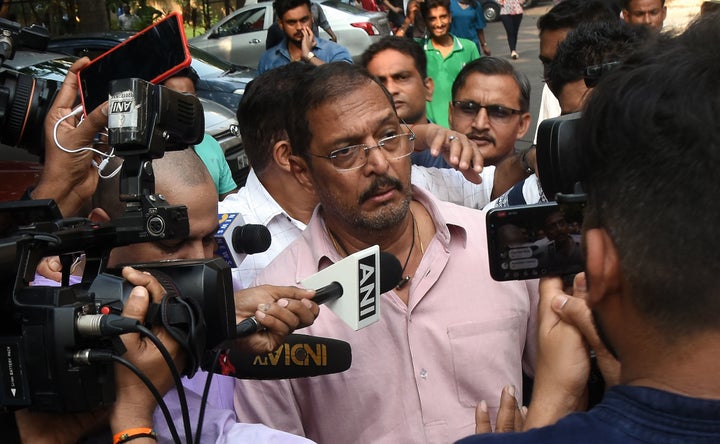
In 2008, an Indian actress named Tanushree Dutta was set to appear in a film, “Housefull,” alongside actor Nana Patekar. Patekar had been a revered figure in Bollywood for decades and had won numerous awards. Dutta was young and beautiful and relatively new to the industry; she had won the Miss India Universe title a few years prior, and had successfully made the transition into movies.
Her role in the film was a small one, a so-called item number in which she was to dance to one song alongside Patekar. Instead, Dutta says, she was sexually harassed on the job. She alleges that Patekar took over choreography for the song himself and groped her during dance rehearsals. As she left the set later, she was hounded by a mob that smashed the windows of her car. When she stood up for herself, she was fired and replaced by another actress.
The incident made national news that year, and Dutta explicitly named Patekar as her harasser. But the response, from both the media and the public, was tepid at best.
Fast forward to September, when Dutta came forward about the incident once more. This time, after a year of Me Too stories making waves around the globe, she was finally heard. India was catapulted into its own Me Too moment, and hundreds of women used social media to post their accounts of being harassed. They did so in such huge numbers that, in October, when Google Trends released a visualization of the heat generated by Me Too searches around the world, India burned the brightest.
“When Google Trends released a visualization of the heat generated by Me Too searches around the world, India burned the brightest.”
To date, all of these accusations have come from women with power. They are celebrities, or professional and upper-middle-class women in film, advertising, publishing and journalism. Their stories have exposed truths about men in eminent multinational organizations that, for years, were brushed aside or hidden.
And though this is happening a few oceans away from the United States, it has the potential to create seismic changes here. Bollywood puts out an average of 1,000 movies annually, which are consumed by an estimated 2.7 billion people worldwide. What happens there is a matter of global economic and cultural importance.
Already, Indian companies are toppling amid sexual harassment scandals. A prominent Indian production house, Phantom Films, has dissolved after a co-founder was accused of predatory behavior toward an ex-employee. The company was owned by Reliance Entertainment, part of the Reliance Group, with total assets worth approximately $110 billion. A vast number of Bollywood projects are being pulled. The fourth film in the “Housefull” franchise replaces Patekar, with rumors his scenes are being reshot with a new actor. Even though Patekar only was involved in 10 days worth of footage for this installment, some estimates put the additional cost of the reshoots at about $300,000.

Though it is challenging to put a rupee or dollar value on the cost of sexual harassment for victims, for large corporations there is a price tag. There are lost hours, lost employees, legal fees and PR for damage control, to say nothing of consumer-driven boycotts.
There are cultural ripples to consider alongside the economic ones. If the impact of the Me Too movement in the West, and in the U.S. in particular, are any guide, India’s will change a lot of what happens in Indian cinema. That change is desperately needed in Bollywood, which has long normalized traditional gender roles. In 4,000 Hindi movies and 800 trailers released from 1970 to 2017, female roles were both trivialized and used as a lure for cinema audiences, according to an analysis by IBM, IIT and DTU.
In other words, Bollywood is still using butts and boobs to sell tickets, especially in movie posters, and typically the actresses whose “assets” are on display get less screen time and less money than their male counterparts.
“Bollywood is still using butts and boobs to sell tickets, and the actresses whose 'assets' are on display get less screen-time and less money than their male counterparts.”
As it is in Hollywood, it’s too soon to say if the changes wrought in India by Me Too will be sweeping or permanent. But whatever those changes are, they won’t stay confined to India. An estimated 16 million Indians ― roughly double the population of New York City ― reside outside India, and the total Indian diaspora amounts to 31.2 million people. In 2017 there were 4.4 million Indian Americans living in the United States. Where once Indian aunties in Chicago might have taken in a traditional Indian rom-com, today they can choose from the increasingly common women-centric Bollywood narratives. And the number of movies that tell women’s stories is projected to increase further in coming years.
Still, Me Too in India has a long, steep road ahead. Though sexual harassment remains a systemic issue, the ability to fight it is restricted to the privileged few in urban areas. Lower-class, and indeed, lower-caste women remain discounted from this conversation and shut out of the changes that result from it. Once Me Too in India is rises above poverty and culture, it will be truly inclusive to all victims.
Tanushree Dutta is filing fresh civil and criminal cases as India watches on tenterhooks. Though it’s taken an additional year for India to enter the Me Too era, the impact of the case that sparked a hundred others isn’t just local, it’s global. Like women everywhere, Indian women are angry and, for the first time, vocal.
“I am seeing the women who have suffered with the burden for too long,” Dutta said at a recent event. “I am looking at them as human beings who have now let go of the burden on their chest. I am looking at these souls that are now getting liberated.”
Akanksha Singh is a writer and culture journalist based in Bombay.
